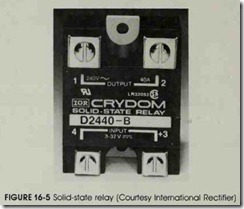Objectives :
After studying this unit, the student will be able to:
• Discuss the differences between de solid-state relays and ac solid-state relays
• Discuss opto-isolation
• Discuss magnetic isolation
• Connect a solid-state relay in a circuit
The solid-state relay is a device that has be come increasingly popular for switching applica tions. The solid-state relay has no moving parts, it is resistant to shock and vibration, and it is sealed against dirt and moisture. The greatest advantage of the solid-state relay, however, is the fact that the control input voltage is isolated from the line device the relay is intended to control, figure 16-1.
Solid-state relays can be used to control de and ac loads. If the relay is designed to control a de load, a power transistor is used to connect the load to the line as shown in figure 16-2. The relay shown in figure 16-2 has a light-emitting diode (LED) connected to the input or control voltage. When the input voltage turns the LED on, a pho todetector connected to the base of the transistor turns the transistor on and connects the load to the line. This optical coupling is a very common method used with solid-state relays. The relays that use this method of coupling are said to be opto-isolated, which means the load side of the re lay is optically isolated from the control side of the relay. Since a light beam is used as the control medium, no voltage spikes or electrical noise pro duced on the load side of the relay can be trans mitted to the control side of the relay.
Solid-state relays intended for use as ac controllers have a triac, rather than a power transis tor, connected to the load circuit, figure 16-3. As in figure 16-2, an LED is used as the control de vice in this example. When the photodetector “sees” the LED, it triggers the gate of the triac and connects the load to the line.
Although opto-isolation is probably the most commonly used method for the control of a solid state relay, it is not the only method used. Some relays use a small reed relay to control the output, figure 16-4. A small set of reed contacts are con nected to the gate of the triac. The control circuit is connected to the coil of the reed relay. When the control voltage causes a current to flow through the coil, a magnetic field is produced around the coil of the relay. This magnetic field closes the reed contacts, causing the triac to turn on. In this type of solid-state relay a magnetic field, rather than a light beam, is used to isolate the control circuit from the load circuit.
The control voltage for most solid-state relays ranges from about 3 to 32 volts and can be de or ac. If a triac is used as the control device, load voltage ratings of 120 to 240 volts ac are common and current ratings can range from 5 to 25 amps. Many solid-state relays have a feature known as zero switching. Zero switching means that if there lay is told to turn off when the ac voltage is in the middle of a cycle, it will continue to conduct until the ac voltage drops to a zero level, and will then turn off. For example, assume that the ac voltage is at its positive peak value when the gate tells the triac to turn off. The triac will continue to con duct until the ac voltage drops to a zero level be fore it actually turns off. Zero switching can be a great advantage when used with some inductive loads such as transformers. The core material of a transformer can be left saturated on one end of the flux swing if power is removed from the primary winding when the ac voltage is at its positive or negative peak. This can cause inrush currents of up to 600% of the normal operating current when power is restored to the primary winding.
Solid-state relays are available in different case styles and power ratings . Figure 16-5 shows a typical solid-state relay. Some solid-state relays are designed to be used as time delay relays. One of the most common uses for the solid-state relay is the I/0 (eye-oh) track of a programmable control ler, which will be covered in a later unit.
REVIEW QUESTIONS
1. What electronic component is used to control the output of a solid-state relay used to control a de voltage?
2. What electronic component is used to control the output of a solid-state relay used to control an ac voltage?
3. Explain opto-isolation.
4. Explain magnetic isolation.
What is meant by zero switching?




